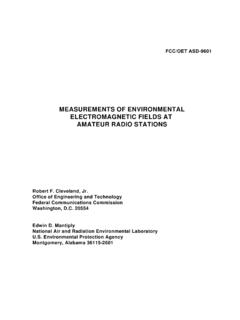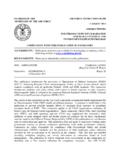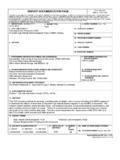Transcription of Magnetic Field Measurement & Simulation of A …
1 Proceedings of the International Conference on Non-Ionizing Radiation at UNITEN (ICNIR 2003). electromagnetic Fields and Our Health 20th 22nd October 2003. Magnetic Field Measurement & Simulation of A 230 kV. Substation Habiballah, Dawoud, K. Al-Balawi, Farag*. KFUPM, Dhahran, Saudi Arabia,* Universiti Tenaga Nasional, Malaysia e-mail: ABSTRACT. The possible effect of 60-Hz Magnetic Field exposure in occupational and residential environments raises the question of how electric and Magnetic fields are created, and what effects they may have. Utilities in particular are interested in the sources and levels of Magnetic fields associated with their transmission lines, feeders, substations and related equipment. Monitoring equipment for electric and Magnetic fields have improved considerably in recent years. The use of this equipment for detection and Measurement of electric fields and Magnetic flux density has helped utilities to characterize exposure to these fields.
2 In order to accurately determine which pieces of equipment within a substation are the main sources of high Magnetic fields, detailed Measurement must be taken. This paper presents the results of Measurement and Simulation of the Magnetic fields on a typical 230 kV. substation in Saudi Arabia. The substation area includes all transformers, circuit breakers, feeders and buses. Measurements of Magnetic fields were taken using the Field STARTM. 1000 meters, developed by EPRI and manufactured by DEXSIL Corporation. Simulation of Magnetic fields was done using SUBCALC Magnetic Field Modeling Program developed by EPRI Environment Division running under Microsoft Windows. The resulting Magnetic Field environment is presented in a variety of graphical formats including contour and three- dimensional maps. KEYWORDS. Magnetic Fields, Measurement , Simulation , Substation. INTRODUCTION.
3 Questions about effects from exposure to power system alternating current electromagnetic fields are of continuing interest to Utilities, Regulators, Consumers and Power Equipment Suppliers. The possible effect of 60-Hz Magnetic Field exposure in occupational and residential environments raises the question of how electric and Magnetic fields are created, and what effects they may have. There is uncertainty about the potential health hazards from these Field exposures. Until there is more definitive information available on the health effect of EMF, it is not possible to determine if there is a safe or unsafe level of exposure [1-5]. Scientists do not agree on how to interpret the currently available information. There is agreement, however, that this is an important issue and that it should be resolved. 1. Proceedings of the International Conference on Non-Ionizing Radiation at UNITEN (ICNIR 2003).
4 electromagnetic Fields and Our Health 20th 22nd October 2003. There is no doubt, however, that many people are concerned about the Magnetic Field effects of power frequency electric currents associated with AC transmission and distribution systems, appliances, tools, etc. while health studies are in progress, it appears desirable to conduct parallel technical studies related to the electromagnetic fields that can be found in occupational areas. Most interest in EMF research is focused on results of epidemiological studies, which report that cancer risks are increased in people who live or work around electric power facilities [5-6]. Utilities are aware that the public's concerns about this issue are widespread and sincere [6- 13]. They recognize and take seriously their responsibilities to help resolve those concerns. Utilities in particular are interested in the sources and levels of Magnetic fields associated with their transmission lines, feeders, substations and related equipment.
5 The environmental effects of electric fields have been studied since the early 1970's, resulting from the Soviet reports in the 1966 about health problems experienced by men working in 400 kV and 500. kV switchyards, but the effects of Magnetic fields gained publicity only during the last few years as a result of the several controversial epidemiological studies. Monitoring equipment for electric and Magnetic fields have improved considerably in recent years. The use of this equipment for detection and Measurement of electric fields and Magnetic flux density has helped utilities to characterize exposure to these fields. In order to accurately determine which pieces of equipment within a substation are the main sources of high Magnetic fields, detailed Measurement must be taken. Once the main Field sources have been determined, recommendations can be made to reduce the Field levels and substation design can be modified to make use of this information.
6 This paper presents the results of Measurement and Simulation of the Magnetic fields on a typical 230 kV substation in Saudi Arabia. The substation area includes all transformers, circuit breakers, feeders and buses. Measurements were using the Field STARTM 1000. meters, developed by EPRI and manufactured by DEXSIL Corporation. Simulation of Magnetic fields was done using SUBCALC Magnetic Field Modeling Program developed by EPRI Environment Division running under Microsoft Windows. SUBSTATIONS Magnetic Field CALCULATION. There are several assumptions [7-8] taken into consideration in calculating the Magnetic fields in substations, which are summarized as follows: a. Source currents are confined to measured values and current path (earth currents are neglected regardless of their origin). b. The earth is non- Magnetic c. Field distortion is due to steel structure of substation.
7 D. The image current below ground is not accounted for, and e. Induced currents on the counterpoise wires and the ground wires are ignored. Low frequency Magnetic fields are generated by electric currents according to Maxwell's equations [14-15]. Since currents in substation are usually confined to straight conductors ( lines or buses), Magnetic fields can be calculated by Biot-Savart law: 2. Proceedings of the International Conference on Non-Ionizing Radiation at UNITEN (ICNIR 2003). electromagnetic Fields and Our Health 20th 22nd October 2003. o idl 4 r 2 r B= a (1). Where: i: is the current flowing through the conductor r: is the distance between an observation point and a source point. r: is a unit vector directed towards the observation point. There are two significant models of sources in analysis of Magnetic fields in substations namely, point source and long-conductor source.
8 The current carrying conductors are modeled as point source if length (l) of conductors or conductor spacing (d) is much smaller than distance (r). The Magnetic Field for single, double, and triple conductors are given as: o I o For single: B= 2. l (2). 4 r I. For double: B= o o 3. dl (3). 2 r o I o For triple: B= 3dl (4). 2 r 3. The current-carrying conductors are modeled as long conductor source if conductors are much larger than distance r, as well as conductor spacing d is much smaller than r. The Magnetic Field for single, double, and triple conductors is given as: o I o For single: B= (5). 2 r o I o For double: B= 3dl (6). 2 r o I o For triple: B= 2. d (7). 2 r The basic elements in substations are: buses, cables, transformers, circuit breakers, capacitor banks, etc. From the perspective of Magnetic Field , these elements can be grouped into two distinct categories: conductor-type elements ( buses) and equipment-type elements that have additional metallic parts beside conductors, which might affect fields around theses elements.
9 3. Proceedings of the International Conference on Non-Ionizing Radiation at UNITEN (ICNIR 2003). electromagnetic Fields and Our Health 20th 22nd October 2003. The following information is necessary for the evaluation and presentation of substation Magnetic Field calculations, simulations and measurements [7-8,19,21]: A) Geometry (i) Substation layout plan, description of components. (ii) Conductor, tower and substation geometry, including configuration, phasing, sag and clearance data, (iii) Test traverse location, level and direction, and (iv) Location of test points. B) Electrical Parameters (i) Line voltage, bus voltage, (ii) Real and reactive line and transformer loads, (iii) Waveshape, harmonic content (if available), (iv) Location of electrical measurements, and (v) Grounding conditions. C) Magnetic Filed Meters (i) Types of meters and probes, based on single-axis or multiple-axis principles, (ii) Characteristics, and responses, (iii) Calibration information and correction factors, and (iv) Height of meter during measurements, positioning and orientation, of the meter.
10 D) Micellaneous (i) Description of environment, (ii) Time and duration of measurements, (iii) Coordinate system, and (iv) Correlation of Magnetic Field and load variation Magnetic Field Measurement OF THE 230 KV SUBSTATION. The substation Magnetic fields are somehow more complex and more difficult to measure than the Magnetic fields near power lines or homes. The substations are complex concentration of Magnetic Field sources, which consist of many interconnecting points for transmission and distribution lines. The line currents passing through substations bus and equipment produce Magnetic fields within the substations, which have much, the same attributes as Magnetic fields beneath the lines themselves. The close proximity of substation equipment and the grounding mat complicate the Field attributes especially the spatial variability to some extent but do not inherently change the nature of the Magnetic Field .













